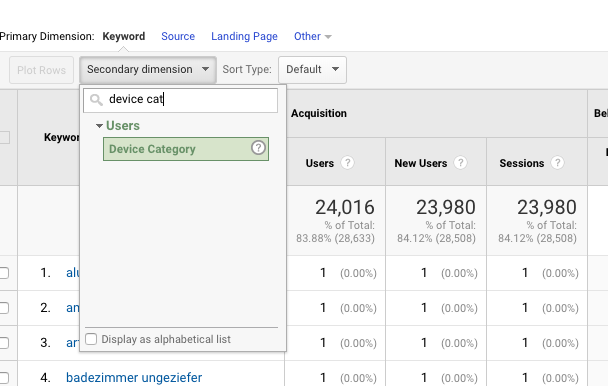Improve Your Data Analysis with Secondary Dimension in Google Analytics
Improve Your Data Analysis with Secondary Dimension in Google Analytics
Blog Article
Unlock Deeper Insights With Additional Measurement in Google Analytics
With the large area of information readily available in Google Analytics, the use of additional measurements can substantially enrich your analytical capacities. By purposefully including secondary dimensions into your analysis, you can uncover useful insights that might or else stay obscure - Secondary Dimension in Google Analytics.
Understanding Primary Vs. Additional Dimensions
When examining information in Google Analytics, it is vital to differentiate in between secondary and key measurements to get much deeper insights into customer habits. Primary dimensions are the major groups by which you can see your information, such as gadget, landing, or source/medium page. These dimensions provide the fundamental structure for arranging and understanding your data. On the various other hand, secondary dimensions allow you to more dissect your primary measurement data. By including a secondary dimension, you can layer on extra info to your primary dimension, making it possible for a more granular evaluation. For example, if your key dimension is the source/medium where individuals got here on your website, including a secondary measurement like geographical location can reveal where those customers are situated geographically. This included layer of details can help you recognize trends, patterns, or abnormalities that may not have actually been evident when considering the key dimension alone. Therefore, leveraging both secondary and primary measurements in Google Analytics is important for extensive data evaluation and educated decision-making.
Using Additional Dimensions Successfully
By integrating secondary measurements alongside key dimensions, analysts and marketers can dive much deeper right into the specifics of user interactions on their web sites. Additional measurements allow customers to sector and filter key dimension information better, using a more thorough sight of customer actions, communications, and demographics.
Furthermore, second dimensions make it possible for users to compare and contrast various information points within a solitary report, helping with a more detailed evaluation of individual behavior patterns. By leveraging secondary dimensions properly, services can uncover hidden insights, enhance their marketing approaches, and improve the overall customer experience on their web sites.
Checking Out Common Additional Measurement Mixes
To even more examine customer actions and fads in Google Analytics, it is beneficial to check out typical mixes of second measurements. By incorporating various second dimensions, experts and online marketers can gain much deeper insights right into just how numerous aspects engage and influence web site performance. Some typical secondary dimension mixes that provide important understandings consist of assessing website traffic resources with user places to understand where internet site site visitors are coming from geographically and just how they located the website. Incorporating touchdown web pages with tools can reveal which web pages do best on different tools, helping in optimizing the site for better individual experience. Additionally, checking out customer habits metrics with secondary measurements such as demographics or rate of interests can help in targeting certain target market sectors much more properly. By discovering these usual additional measurement combinations, organizations can uncover surprise patterns, determine chances for improvement, and make data-driven decisions to improve their on the internet existence.
Using Second Measurement in Customized News
Making use of secondary measurements in custom-made records enables a much more extensive evaluation of data in Google Analytics, enhancing the depth of insights obtained. When developing custom-made reports in Google Analytics, including second dimensions can supply a much more comprehensive sight of how numerous dimensions communicate with each various other. This attribute enables individuals to delve much deeper right into their information and uncover valuable correlations that may not be quickly apparent.
By using secondary dimensions in personalized records, users can gain a better understanding of their website or application traffic. Incorporating the primary measurement of "source/medium" with the secondary measurement of "landing web page" can reveal which touchdown web pages are carrying out ideal for web traffic coming from specific sources. This understanding can aid marketers maximize their projects and improve general conversion prices.

Enhancing Data Visualization With Secondary Measurement
When exploring information in Google Analytics customized records, integrating additional dimensions not only provides an extra comprehensive evaluation however also improves the visual representation of insights via information visualization. By including more info here an additional dimension to your records, you can enrich the means information exists, making it easier to determine patterns, fads, and correlations within your website's efficiency metrics.
Secondary dimensions can help you section your data additionally, permitting a much deeper understanding of individual habits and communications on your site. This enhanced degree of granularity can be specifically useful when trying to separate specific variables that might affect your internet site's efficiency - see page Secondary Dimension in Google Analytics.

Verdict
To conclude, leveraging additional measurements in Google Analytics allows for an extra detailed analysis of information, bring about much deeper insights and even more educated decision-making. Secondary Dimension in Google Analytics. By including additional layers of details to primary information collections, analysts and marketing experts can discover covert fads, patterns, and connections that provide a granular view of user behavior and interactions. This improved level of insight allows optimization of projects and tailored strategies for certain target market sectors, eventually improving performance and conversion prices
On the other hand, secondary measurements permit you to additional dissect your main dimension information. By including a second measurement, you can layer on added information to your primary dimension, enabling an extra granular analysis. If your primary measurement is the source/medium with which customers got here on your website, including a second dimension like geographic location can expose where those customers are located geographically. By including secondary dimensions along with key dimensions, online marketers and analysts can dive much deeper right into the specifics of user interactions on their websites. Secondary dimensions enable individuals to section and filter main measurement information further, find more info supplying a much more in-depth view of individual demographics, habits, and interactions.
Report this page